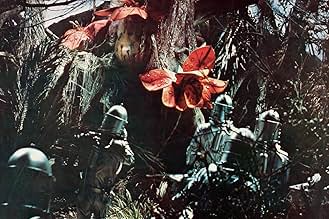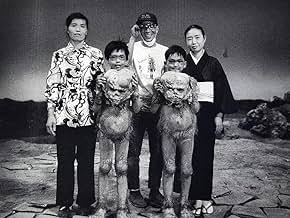AVALIAÇÃO DA IMDb
6,2/10
339
SUA AVALIAÇÃO
Adicionar um enredo no seu idiomaA scientist fears that the prophecies of Nostradamus, including the end of all life on Earth, are coming true one after another.A scientist fears that the prophecies of Nostradamus, including the end of all life on Earth, are coming true one after another.A scientist fears that the prophecies of Nostradamus, including the end of all life on Earth, are coming true one after another.
- Direção
- Roteiristas
- Artistas
Kyôko Kishida
- Narrator
- (narração)
Avaliações em destaque
I know a lot of people don't like this movie, but I really enjoyed it. I'm not a big sci-fi fan, but there is something about this one I really enjoyed. The special effects are cheesy, and it gets silly, but I really got a kick out of it.
Oh, what a wonderful movie!!!! I loved it!!! Ok, special effects are a little weak, but the script was terrific!!!
Depending on which version you see, it's either an epic masterwork or, a truncated mess. Originally, the film was a 1974 follow-up to the highly successful SUBMERSION OF JAPAN(1973). By this time, revenues for Godzilla had been falling and Toho saw more money in the disaster film genre. PROPHECIES OF NOSTRADAMUS was the next great, epic they did. The original cut is quite long and details the events that lead to world destruction by nuclear weapons. They had to work some monsters in there so what we get are giant slugs(about a foot or two long) and, giant bats(looked about four feet across). Details the story of a family in Japan-a 1970's polluted country-and how the excesses of pollution, famine and finally, war, effect them. Ostensibly, it's a loose remake of THE LAST WAR from 1961, by Toho. It even features stock footage from that film. There are some quite remarkable effects-a convexed reflection in the sky, of Tokyo thanks to a polluted and sweltering greenhouse effect which has occurred. A terrific matte painting of snow covered pyramids. And, later, a nuclear-blasted landscape of earth wit two VERY weird mutants scurrying for food. It was quite epic for it's time and a long film.
In 1983 or thereabouts, Henry G Saperstein's company UPA(which had under it's belt five Godzilla films and some other Toho works) acquired the film and edited it down to a scant 90 minutes, and re-framed it, and had it narrated in the style of the old Sun Classic Pictures and those strange pseudo-documentaries that got wide releases on secondary markets in the US through the 1970's. They even named it THE LAST DAYS OF PLANET EARTH(kind of like THE LATE GREAT PLANET EARTH, another 70's pseudo-documentary) The result is kind of a mess, and while it retains some of the cool imagery, it jettisons a lot more making scenes jump along inexplicably and the whole thing becomes a "THis was just a possibility. We can change the future" kind of ending. It then was sold directly to VHS and TV so it wound up appearing usually very late at night on the old TNT "100% Weird" and AMC(when they showed a lot of old retro movies).One scene that was excised, for a time, in the Japanese LAser Disk print was that of the mutant humanoids fighting over a worm. It was such a disturbing scene that Toho removed it after complaints from Hiroshima survivors and such. So it made the US print highly sought after even in the truncated and panned and scanned form(the US VHS and LD copies were from a 16mm print) in Japan. Later, Toho would restore the scene.
Perhaps the US holders of the film, Classic Media, will see to releasing this film in it's full Japanese version.
In 1983 or thereabouts, Henry G Saperstein's company UPA(which had under it's belt five Godzilla films and some other Toho works) acquired the film and edited it down to a scant 90 minutes, and re-framed it, and had it narrated in the style of the old Sun Classic Pictures and those strange pseudo-documentaries that got wide releases on secondary markets in the US through the 1970's. They even named it THE LAST DAYS OF PLANET EARTH(kind of like THE LATE GREAT PLANET EARTH, another 70's pseudo-documentary) The result is kind of a mess, and while it retains some of the cool imagery, it jettisons a lot more making scenes jump along inexplicably and the whole thing becomes a "THis was just a possibility. We can change the future" kind of ending. It then was sold directly to VHS and TV so it wound up appearing usually very late at night on the old TNT "100% Weird" and AMC(when they showed a lot of old retro movies).One scene that was excised, for a time, in the Japanese LAser Disk print was that of the mutant humanoids fighting over a worm. It was such a disturbing scene that Toho removed it after complaints from Hiroshima survivors and such. So it made the US print highly sought after even in the truncated and panned and scanned form(the US VHS and LD copies were from a 16mm print) in Japan. Later, Toho would restore the scene.
Perhaps the US holders of the film, Classic Media, will see to releasing this film in it's full Japanese version.
I would like to add my voice to those pointing out the contrast between the original long Japanese version and the shortened American version. It is not just a question of length. They are two different movies.
The Japanese version is balanced, thoughtful (believe it or not) and even has some subtle moments. It also leaves room for hope. There is something working in this that is very much lacking in the gargantuan excesses, overcharged adrenalin and endless CGraphics of recent Hollywood disaster indulgences.
The American version teeters between silliness and extreme depression. The dated effects and miniatures might turn you away but if you accept those and watch it through, it hammers away with hopeless imagery. As stark and as semi-cartoonish as the images might be, they are clearly recognizable as being rooted in aspects of the real world or its possibilities. If one is looking for a film to motivate a suicide pact to finally be put into action, this is it.
The Japanese version is balanced, thoughtful (believe it or not) and even has some subtle moments. It also leaves room for hope. There is something working in this that is very much lacking in the gargantuan excesses, overcharged adrenalin and endless CGraphics of recent Hollywood disaster indulgences.
The American version teeters between silliness and extreme depression. The dated effects and miniatures might turn you away but if you accept those and watch it through, it hammers away with hopeless imagery. As stark and as semi-cartoonish as the images might be, they are clearly recognizable as being rooted in aspects of the real world or its possibilities. If one is looking for a film to motivate a suicide pact to finally be put into action, this is it.
10Kabumpo
This film is so powerful that it was successfully banned in its native country. Unfortunately, horrible dubbing and sound mix, commercial fade-outs and other tampering have cheapened the film into only a hint of its original brilliance. The film sports a unique score by Isao Tomita, which, for me, defines the essence of decline in the penultimate year of the 20th century we are now in. Unfortunately, bad choices in American narration cause erratic volume changes which decrease the effect. Critics attacked it for the distinctly seventies fashions which are, as predicted, back in vogue. The film was actually not written by Yasumi, but updated from his script for _Sekai Daisenso_ (_The Last War_) and credited to him out of respect. Perhaps if the film, which is minimal on narrative and seems a forerunner to the work of Godfrey Reggio, were given a widescreen and subtitled reissue (and what better time than this year), respect for the film would increase. It pulls out all the stops with disasters, including the pestilence of giant slugs (which are simply giant slugs, like though that plague India, not flesh-eating or blood-eating as detractors of the film would like you to believe) and plants that tear through subways (and no, they do not eat people as some reviews claim). Nature takes things back from the city, young people find solace in random sex, wanton drug use, and suicide. Traffic jams wreak havoc as people get out of control, food rations are torn away as people believe there are shortages, while luxury beef diets continue, and Nishiyama believes they are all related to the prophecies of Nostradamus. Bizarre effects ensue, like snow on the pyramids, and people's highest morals are challenged. What we have is a work of cinematic brilliance torn apart by an American distributor until what results becomes fodder for MST3K. Know what neurofibromatosis looks like?
Você sabia?
- CuriosidadesSince this was a full-scale production, Toho required the use of all of their own visual effects soundstages. However, during filming of a special effects scene, a pyrotechnical accident caused a fire that burned down part of the main visual effects soundstage, an incident that was very widely reported in Japan at the time. The fire destroyed a number of costumes and props from earlier Toho tokusatsu classics that were kept in storage at the time, including the original Mogera costume from Os Bárbaros Invadem a Terra (1957).
- Cenas durante ou pós-créditosClosing title card reads: The story you have just seen was a work of fiction. The events it portrayed, however, may take place in our world. It's up to you to take action to ensure the these events do not come to pass...
- Versões alternativasThere are three versions of Nosutoradamusu no daiyogen that are known to exist:
- The original Japanese release, "Nosutoradamusu no daiyogen" (literal translation: "Great Prophecies of Nostradamus", which ran at about 114 minutes. After the film was banned in Japan, this version was only shown once on Japanese television in the early 1980's and has since been unavailable except by obtaining copies via the grey market.
- The second version, titled "Catastrophe 1999: Prophecies of Nostradamus" was an English-dubbed variant of "Nosutoradamusu no daiyogen", but was shorn of some 25 minutes of footage. The excised footage consisted of mainly dialogue scenes, but the original prologue and ending were trimmed greatly or excised altogether. The only known release of this variant is a long out-of-print Danish video release, which runs at about 90 minutes (PAL speed).
- The third, and possibly most familiar variant is titled "The Last Days of Planet Earth". This version was for American television showings and was prepared by United Productions of America. For this particular release, the film was cut even further. It actually added an annoying narrator commenting on the events, replacing the original accompanying female voice reading from Nostradamus' predictions. It is this version that has been circulating on video and TV in the United States. Running time: 88 minutes (without commercials)
Principais escolhas
Faça login para avaliar e ver a lista de recomendações personalizadas
- How long is Prophecies of Nostradamus?Fornecido pela Alexa
Detalhes
- Data de lançamento
- País de origem
- Idiomas
- Também conhecido como
- Prophecies of Nostradamus
- Locações de filme
- Tóquio, Japão(location filming, interiors and exteriors)
- Empresas de produção
- Consulte mais créditos da empresa na IMDbPro
- Tempo de duração1 hora 54 minutos
- Mixagem de som
- Proporção
- 2.35 : 1
Contribua para esta página
Sugerir uma alteração ou adicionar conteúdo ausente






























